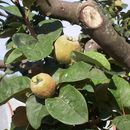Quince (
Cydonia oblonga) is native to
Caucasia in western Asia. During ancient times, Quince spread from its wild center of origin to the countries bordering the Himalaya Mountains to the east and throughout Europe to the west, but it is likely that Quince reached the Mediterranean region only in classical times (it was used by the Romans). Quince has many uses and traditions associated with it throughout this broad range. Quince grows as a multi-stemmed shrub or small tree, 5 to 7 m in height, and has
pubescent to
tomentose buds, petioles (leaf stalks), leaves, and fruit. The leaves are ovate to oblong, around 5 centimeters across and 10 centimeters long. The solitary pink and white flowers, borne at the ends of short young shoots in spring, are 4 to 5 centimeters across and have 5 petals, 20 or more
stamens, 5
styles, and an
inferior ovary with many
ovules. The flowering period overlaps with that of apples, usually beginning in mid-April in the central latitudes of the northern hemisphere. The fruit is a fragrant, many-seeded
pome around 8 centimeters in diameter. It is similar to a pear or apple, but has many ovules in each
carpel rather than just two. The shape ranges from round to pear-like and the flesh is yellow, Fruit size and leaf size of cultivated varieties can be many times larger than the wild type described above. All varieties are self-pollinating. The raw fruit is hard and unpalatable, but when cooked the flesh turns a brownish pink and has a pleasant flavor. A Quince fruit contains around 6% sugar, is a good source of potassium, and has a vitamin C content of 15 mg/100g. The
malic acid percentage is high (0.8%). Quince fruits are used to make jams, jellies, and pastes and to flavor cooked apples and pears.
Dulce de membrillo, or quince paste, is a sweet, fragrant jellylike confection that is popular (under various names) in several European and South American countries. Quince is also served poached in either water or wine and when so prepared develops a rich aroma and deep caramel-red color. In Armenia, Quince is used in many savory as well as sweet dishes and is often cooked with lamb. Quince fruit is also used by some home brewers to make very fine hard ciders. Worldwide, there are around 43,000 hectares (106,000 acres) of Quince in production with a total crop of 335,000 metric tons. Turkey is the largest producer, accounting for about 25% of world production. China, Iran, Argentina, and Morocco each account for less than 10% of world production. The United States is a very minor player in Quince fruit production with only about 250 acres (about 100 hectares) planted, mainly in California’s San Joaquin Valley. While Quince is still grown for its fruit in some parts of the world, in England, France, and the United States it is primarily grown for use as a
dwarfing pear rootstock. In the region around Angers, France, Quince has been used as a pear rootstock since before 1500. The so-called "Flowering Quinces" (
Chaenomeles spp.) can be distinguished from
Cydonia by their toothed leaves and the united (not free) styles in their flowers.
Chaenomeles fruits are more acidic than those of from
Cydonia, but can nevertheless be used in similar ways. (Vaughan and Geissler 1997; Postman 2009 and references therein)

